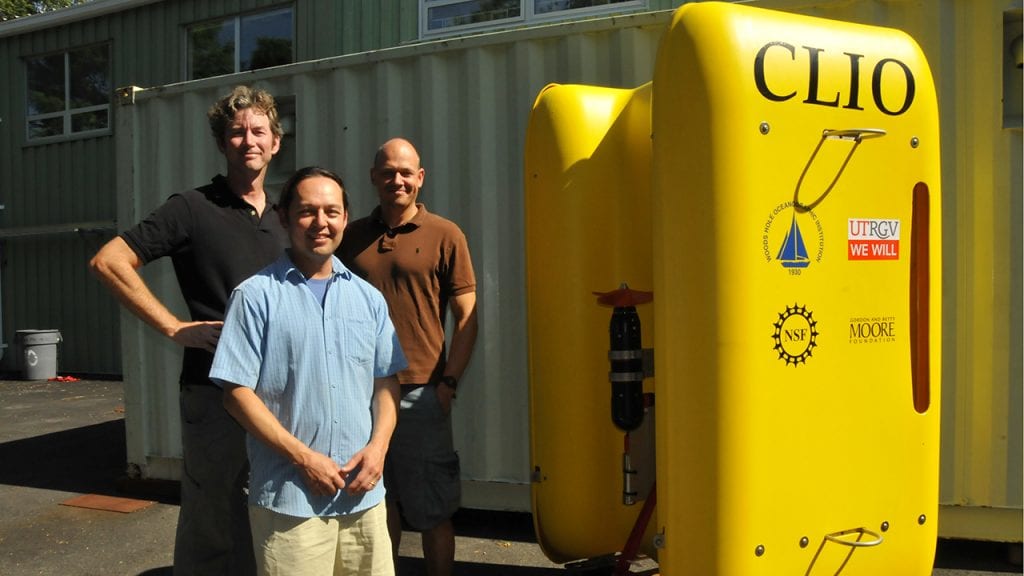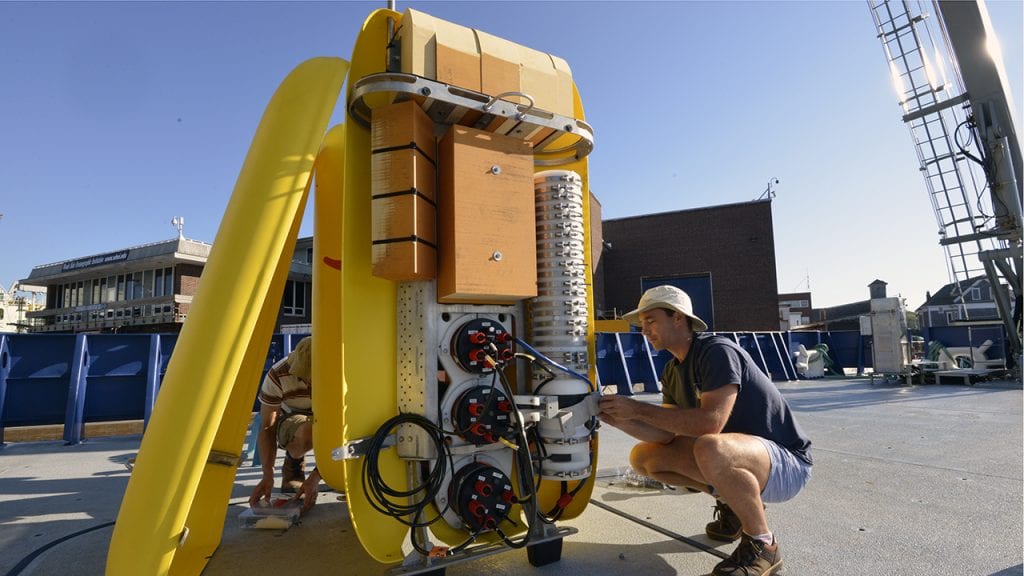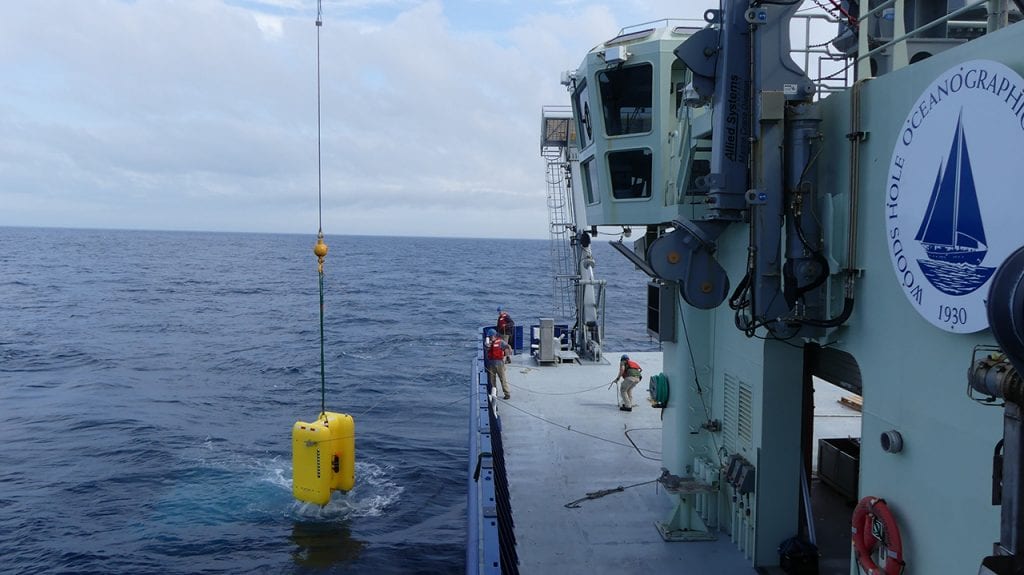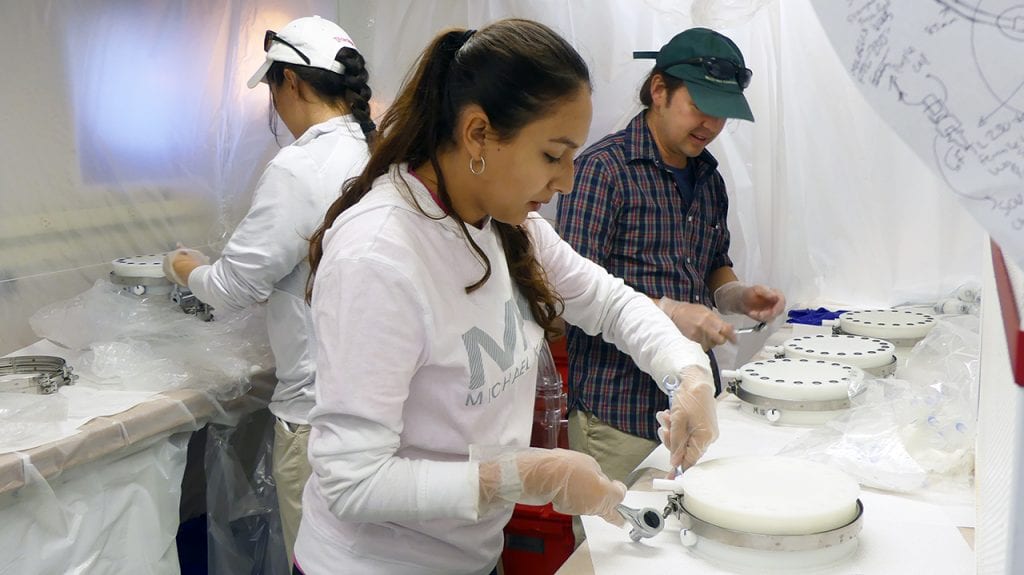New Robot Speeds Sampling of Ocean’s Biogeochemistry and Health
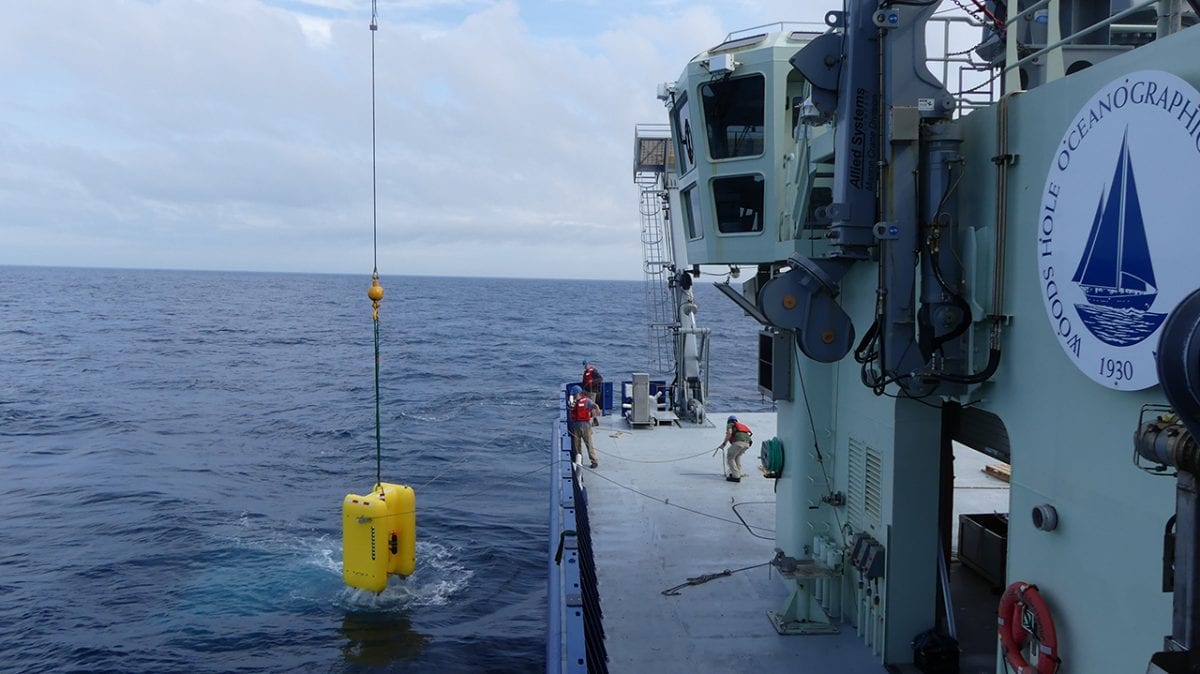
July 26, 2017
The world’s first underwater vehicle designed specifically to collect both biological and chemical samples from the ocean water column successfully completed sea trials off the coast of New England on July 9, 2017. The new autonomous underwater vehicle (AUV), named Clio, will help scientists better understand the inner workings of the ocean.
Developed in an engineering collaboration between Woods Hole Oceanographic Institution (WHOI) and the University of Texas Rio Grande Valley (UTRGV) and in scientific collaboration with the University of Michigan at Ann Arbor, Clio will improve sampling efficiency and also reduce the time and cost of broad biogeochemical surveys, which are necessary to understand patterns and cycles of the marine food web and the role that the ocean plays in shaping Earth’s climate.
“The long-term goal of Clio is to lower the barriers to completing a global survey of marine microbiology and biochemistry,” says John “Chip” Breier, chief scientist of the sea trials and lead principal investigator of the project from UTRGV. “Ultimately, the vehicle’s capabilities will greatly expand the observational capacity of our oceanographic research fleet.”
Cutting the Cord
Currently, researchers gather these types of samples by using battery-operated pumps, lowered down to various ocean depths on a wire. The pumps suck seawater through a filter that also captures particles. When the pumps are back on deck, the heads containing the filters are removed and brought to a lab for analysis.
“The current sampling system works quite well,” says Mak Saito, a biogeochemist at WHOI and one of the principal investigators. “But in large survey programs where we are intensively sampling at many unique locations across major ocean basins, it will greatly improve efficiency to be able to move one operation off the ship’s wire and onto an AUV.”
Almost a decade before the development of Clio, Breier, then a scientist and engineer at WHOI, designed a SUPR (SUspended Particulate Rosette) sampler—a chemical and biological sampler shaped like a hockey puck that could be used with remotely operated vehicles to collect samples from hydrothermal vents on the ocean floor. For this project, Breier adapted the state-of-the art sampler to fit inside an AUV to enable it to sample at various depths in the water column.
“From the sampling perspective, we had to design a system that was versatile enough to meet the scientific needs of a wide community, simple enough to operate rapidly and with little training, and compact enough to fit in the AUV—a challenge to be sure” says Breier, now an associate professor at UTRGV and adjunct scientist at WHOI.
Once lowered off a ship, the vertical-diving Clio propels itself to the bottom of the seafloor using a pair of thrusters and then stops at a series of pre-programmed depths during its ascent to filter water and collect samples.
The AUV, which is roughly the size of a large refrigerator, can dive to a maximum depth of 6,000 meters (3.7 miles) and operate underwater for 12 to 14 hours at a time. Clio then returns to the surface with stacks of filters representing 100s of liters of seawater that oceanographers can use to measure the genetic and functional diversity of marine microorganisms, as well as nutrients that control their diversity.
“As an AUV, Clio occupies a unique design space,” says Mike Jakuba, lead engineer at WHOI and a principal investigator on the project. “AUVs are typically designed to travel horizontally along the seafloor, and to survey at a relatively constant depth. By contrast, Clio must travel vertically in the water, and sample for long periods of time at many depths separated by hundreds to thousands of meters”
Jakuba designed Clio to be as compressible as it is practical, so that, as the water density around it increases with depth, its buoyancy changes relatively little. That saves battery energy that would otherwise be expended fighting buoyancy and avoids the need for complex active variable ballast systems.
“Clio’s unique shape is low drag to minimize the battery energy expended while travelling in the water column, and it also enables ready access to the samplers once on deck,” Jakuba says. “Clio also needs to avoid affecting the biological and chemical samples it collects, especially by leaching iron into the water column, so the vehicle uses almost no iron-containing materials in its construction.”
On major expeditions that survey across entire ocean basins, Clio can be in the water performing a survey, while other researchers can concurrently take separate sets of samples using the wire system. To demonstrate this capability during sea trials earlier this month aboard the R/V Neil Armstrong, the cruise science party deployed a standard wire-mounted oceanographic instrument known as a CTD rosette, which measures conductivity, temperature, and depth, while Clio simultaneously filtered samples at depth a few 100 meters away.
During the expedition, Clio completed five dives, including two dives to 2,000 meters (1.2 miles), and filtered more than 1,000 liters (264 gallons) of seawater from nine different depths for microbiological and biochemical analysis.
Measuring the Microbiome
The team, which also includes Gregory Dick, a marine microbiologist from the University of Michigan at Ann Arbor, hopes that surveys by Clio can be used to expand existing sampling efforts, such as the long-running GEOTRACES study—an international effort to measure and study a wide spectrum of elements, isotopes, and chemicals in the ocean—by providing biological and biochemical counterparts.
“One of the really exciting things is that Clio provides the type of biomass samples needed for the new ‘omics’ approaches to measuring cellular molecules, such as genomics, proteomics, and metabolomics,” Saito says. “The biomass in the filters will help reveal the responses of marine microbes to environmental stressors and provide diagnostic information on the biogeochemical functions of the ocean.”
By analyzing the biomass Clio collects, scientists can tell what’s living in the water and the nutrients they are using to perform biological functions, and also learn more about the ocean microbiome—the microbial system that helps drive life processes and elemental cycling on Earth.
Next up, Clio will undergo a year of science testing in Bermuda beginning in April 2018. Funding for the design and development of Clio was provided by the National Science Foundation’s Ocean Technology and Interdisciplinary Coordination Program and the Gordon and Betty Moore Foundation.
The Woods Hole Oceanographic Institution is a private, non-profit organization on Cape Cod, Mass., dedicated to marine research, engineering, and higher education. Established in 1930 on a recommendation from the National Academy of Sciences, its primary mission is to understand the ocean and its interaction with the Earth as a whole, and to communicate a basic understanding of the ocean’s role in the changing global environment. For more information, please visit www.whoi.edu.

